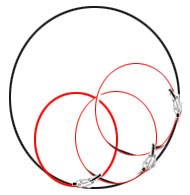BILL– Let’s start with some assumptions. You’re able to make a correct shoulder-in along the rail—the horse is in front of your legs; he is in lateral balance; he accepts the bit; and he follows your weight so that you don’t have to poke him every stride to perform the movement.
If all these things are following the script and you’re having trouble making one on a circle, I think your problem is a conceptual one. In a conventional shoulder-in you can begin the movement from a 10 meter circle or come around the corner, ride the first stride of a 10 meter circle to bring the forehand off the track, and then “change your mind” carrying the horse forward and sideways down the line. Once you have established his angle relative to the line, it stays the same until the end of the movement.

Life is more complicated on the circle. You can start the shoulder-in the same way, but before you know it, the line has fallen away from you and you are drifting on a tangent out into space. If you’re like most people, when you notice this happening, you pull more on the inside rein, the horse overbends, and tips even farther onto his outside shoulder.
The trick is to remain faithful to the bending line of the circle’s circumference. Burn that line on the ground indelibly into your brain. Imagine the same first stride of a 10 meter circle to bring the forehand to the inside. Push the horse sideways one step and then imagine starting a new 10 meter circle. Again only bring the front end around the first stride of it and then push him sideways again. Do this stride by stride by stride and you will keep him correctly positioned relative to the curving line of the big circle you’re trying to ride.
Also keep in mind that the most frequently neglected aid in all shoulders-in is the rider’s outside leg. It should stay on the horses flank behind the girth as a barrier to prevent his haunches from swinging out and to direct his energy forward into the outside rein to help keep him in lateral balance.
If despite all this, you are still having trouble, try to visualize the exercise from above. Imagine that you’re floating in a balloon looking straight down at yourself. The aids that you need to position the horse and herd him around the line will be self evident from that vantage point.
